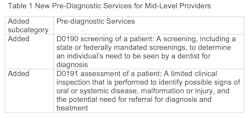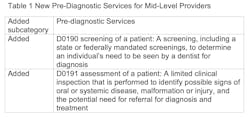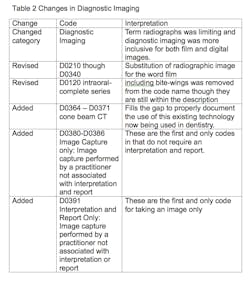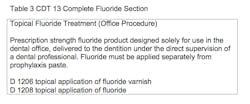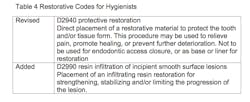Dentalcodeology: 2013 CDT Bottom Line Changes for Insurance and Dental Hygiene
Consider reading:3 tips for increasing new patient appointments: What to say and do on the phone
Consider reading:The changing landscape of the dental hygiene profession
Consider reading:A five-step behavioral approach to grow your dental practice
The CDT 2013 update focuses on new technologies and materials. Viewing the changes in codes only through the perspective of what is immediately affected can miss the larger picture of a shifting arena. Though it is not known when dentistry will be required to use interoperable electronic health records (EHR), many changes in coding are being put into place for this to happen.
Change #1: New Code Book Every Year
Code maintenance is the responsibility of the Code Maintenance Committee (CMC), which was formed in 2012. It has been the role of the Code Revision Committee created through an ADA-Delta litigation agreement approximately 10 years ago.
The new committee has a different process for developing codes, including those for electronic health records. Procedure codes were traditionally the only codes in dentistry and were for processing payment. For a patient health record, codes are needed to capture the workflow in an office for an electronic health record. Part of this process incorporates best practices from other entities, maintaining HIPAA medical code sets such CPT and ICD-9-CM (ICD-10 starts November 2013). This process is taking dentistry closer to interoperability with the rest of health care.
For the past decade, the codes were updated every two years. To facilitate technological changes in the electronic transmission environment, this new committee will update CDT every year. New and continued research demonstrates oral with systemic health connections. Creating codes to embrace new technologies and materials can lead to earlier arrest and prevention of oral disease. The existence of code does not mean a patient has coverage under a policy. Yet without a code, no coverage could be offered.
Bottom line: Staying current on coding is a continuous process.
Change #2: Codes for Dental Hygiene Providers with Direct Access
The many provisions to the Affordable Care Act (ACA, known as Obamacare to many consumers) will have consequences on dentistry in both the public and private arenas. Pediatric oral care is considered an essential health benefit. An estimated 3 million children in the private practice market will benefit. The number in public health is less clear and could range from 11 million to as much as 24 million with many details are yet to be determined.
This influx will increase demand for mid-level providers. The profession of dental hygiene has an existing workforce that can make a powerful difference. Currently, 15 states have statutory or regulatory language allowing Medicaid to directly reimburse dental hygienists (ADHA 2010). In addition, dental hygienists have some type of direct access in 35 states. ADHA defines direct access as: the dental hygienist can initiate treatment based on her/his assessment of needs without the specific authorization of the dentist, treat the patient without the dentist present and maintain a provider-patient relationship (ADHA 2012).
A new sub-category was added to the Diagnostic section to accommodate two new codes as shown in Table 1.
Bottom line: New pre-diagnostic codes do not require diagnosis by a dentist and are expected to be very useful for dental hygienists providers with direct access.
Change #3: Radiographs/Diagnostic Imaging
The Diagnostic Imaging (formerly Radiographs) section contains the greatest number of changes as shown in Table 2. The name of the section was changed to reflect all types of images taken within the practice. Every code in this section has seen “radiographic image” replace the word “film.” For D0210, intraoral-complete of radiographic images (often called FMX) the words “including bitewings” was removed. It is a change with little meaning to a clinician because “bitewings images” is still contained within the description.
Major changes were made for cone-beam tomography technology (CBCT). Only two codes were available in the past; both have been deleted and replaced by 16 new codes. This fills the gap to properly document the use of this existing technology now being used in dentistry as explained in the ADA Council on Scientific Affairs advisory statement (ADA 2012).
Of greater interest are the two additional codes for image capture and the dentist’s interpretation of CBCT. These two new CBCT codes are the first and only codes in that do not require an interpretation and report. The process of having separate codes is similar to a medical process. It appears to be another step to taking dentistry closer to interoperable electronic health records.
The descriptor for this section did not change and states: “Should be taken for clinical reasons as determined by the dentist.” Radiographs are often taken at the beginning of the appointment on an annual or biannual basis. In 2012, the ADA and the Food and Drug Administration (FDA) updated the Dental Radiographic Examination Recommendations. Those guidelines state, “Radiographic screening for the purpose of detecting disease before clinical examination should not be performed.” In other words, it should no longer be routine to take radiographs prior to an examination and based only on the passage of time. The ADA/FDA guideline provides a list of reasons for taking radiographs. The reason and the result of images should be documented.
Bottom Line: Download and read 2012 ADA/FDA Dental Radiographic Examination Recommendations.
Change #4: Fluoride Codes
Table 3 shows all words in CDT 2013 in the fluoride section. The deletion of old codes D1203 and D1204 eliminates any age-based language. For D1206 fluoride varnish, the entire description and risk-based language in previous CDT versions was removed.
Hygienists do not often consider codes in the restorative section. This is no longer the case with CAMBRA and changing technologies. The atraumatic restorative treatment (ART) approach was born 25 years ago in Tanzania and defined as a minimally invasive care approach in preventing dental caries and stopping its further progression. The ART technique involves the excavation of cavitated carious lesions with hand instruments and temporary restoration with a glass ionomer restorative material. Code D2940 was added to CDT 2011-2012. In this new version, the word ‘temporary’ was removed (see Table 4 for full description).
